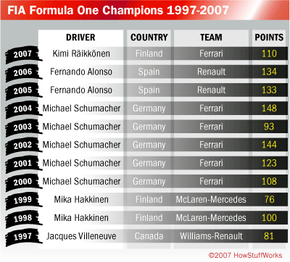Grand Prix Preparation
Few sports have the same logistical issues as motor sports do, and for Formula One in particular, with circuits spread to the far corners of the globe, logistics is an enormous challenge.
The first challenge involves transportation of team members. Normally, about 100 people travel from the team's headquarters to the grand prix. The team must also rent cars, buses and vans -- or, if the race is in a highly congested area, charter helicopters. At the track itself, the team operates from a large mobile facility. A catering staff prepares meals for the team in a kitchen that could rival many restaurant kitchens.
Advertisement
Most teams transport three cars, one spare chassis and several spare engines to each race. Technical partners and local contractors ship tires, fuel and other equipment not manufactured by the team. All teams are headquartered in Europe, so for the European races, they'll pack their equipment into articulated trucks and drive it to the destination. For the races in Asia, Australia and the Americas, the teams fly out their equipment on transport planes.
Formula One races are on Sundays, and everything must be set up and ready to go by Friday morning, when practice and qualifying sessions begin. Drivers can practice as much or as little as they want during the sessions, but their goal is to sort out how to set up the car to achieve maximum speed on that particular track, in specific weather conditions. The driver, working closely with the race engineer, will choose suspension and aerodynamic settings, pick tires and determine optimal fueling. The race engineer and the driver will continue to communicate and tweak their strategy during the race.
The two qualifying sessions almost immediately follow the practice sessions. Friday qualifying measures one thing -- speed around a single lap. The car has to carry only enough fuel to get it around the track once. The results from Friday determine the lineup on the next day.
Saturday qualifying is a bit different. The rules specify that no fuel can be added between the end of Saturday qualifying and the driver's first pit stop during the race on Sunday. That means cars are much heavier on the second day of qualifying and much harder to control. If a driver spins out of control or leaves the track, he doesn't get a second chance. He must either continue the lap or abort it altogether. Either way, he will not enjoy a favorable position on Sunday. Aborting the lap does offer one advantage: The driver will have more fuel at the start of the race, which could help him gain an advantage over the rest of the field.
Saturday's fastest driver gets to sit in the pole position on Sunday, which means he starts from the very front. This has obvious advantages in any kind of race, but for Formula One, it is particularly advantageous, mainly because overtaking another car is a rarity. The other racers line up behind the pole position based on their Saturday performance, forming a two-row grid. Once all of the cars have passed a prerace inspection, a final grid is issued and the stage is set for the race.
On the next page we'll find out what happens after the race finally gets under way.
